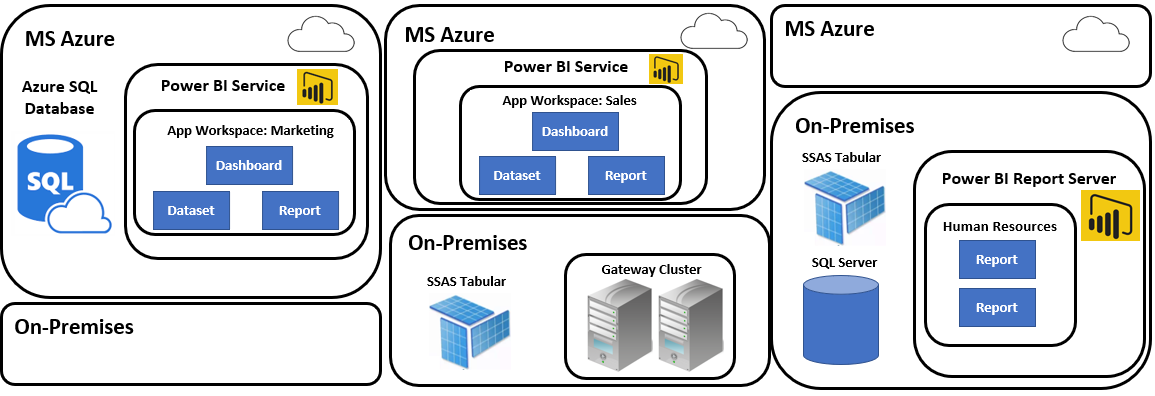The Power BI Report Server, along with the ability to embed Power BI content into custom applications, gives organizations the option to choose a single deployment model (such as Power BI Report Server only) or a combination of deployment models in which both the Power BI Report Server and the Power BI service are utilized for distinct scenarios or content.
With both the Power BI service and the Power BI Report Server available via Power BI Premium capacity, an organization could choose to match the deployment model to the unique needs of a given project, such as using the Power BI Report Server if traditional paginated reports are needed, or if the reports need to remain on-premises for regulatory reasons.
For example, one Power BI solution for the marketing organization could be completely cloud-based, such as using Azure SQL Database as the source for Power BI reports and dashboards hosted in the Power BI service. A different solution for the sales organization could use the On-premises data gateway to query a SQL Server Analysis Services model (on-premises) from the Power BI service, as described in Chapter 15, Managing the On-Premises Data Gateway. Finally, for scenarios in which both the data source(s) and the report/visualization layer must remain on-premises, such as for sensitive reports used by the human resources organization. Power BI reports developed against on-premises sources could be deployed to the Power BI Report server.
The following diagram describes the essential architecture of three distinct Power BI solutions: cloud only, cloud and on-premises, and on-premises only:

In this example, Power BI reports and dashboards developed for the marketing department are hosted in the Power BI service and based on an Azure SQL Database. The sales team also has access to dashboards and reports in the Power BI service, but the queries for this content utilize a Live connection to an on-premises SSAS model via the On-premises data gateway. Finally, Power BI reports developed for the human resources department based on on-premises data sources are deployed to the Power BI Report Server.
BI solutions that utilize PaaS and SaaS cloud offerings generally deliver reduced the overall cost of ownership, greater flexibility (such as scale up/down), and more rapid access to new features. For these reasons, plans and strategies to migrate on-premises data sources to equivalent or superior cloud solutions, such as Azure SQL Data Warehouse and Azure Analysis Services, is recommended.
If multiple Power BI deployment models are chosen, BI teams should understand and plan to manage the different components utilized in different models. For example, identify the administrators, hardware, and users of the On-premises data gateway. Likewise, identify the Power BI service administrators and the tenant settings to apply, as described in Chapter 18, Administering Power BI for an Organization. Additionally, as discussed in the Upgrade cycles section later in this chapter, organizations can choose either a single Power BI Desktop version to utilize for both the Power BI Report Server and the Power BI service, or run separate versions of Power BI Desktop side by side.
BI teams responsible for managing these more complex deployments should have monitoring in place to understand the utilization and available resources of the alternative deployment models. For example, rather than adding resources to a Power BI Report Server or adding another report server in a scale-out deployment, certain Power BI reports could be migrated to available to premium capacity in the Power BI service. The Power BI Premium capacities section in Chapter 18, Administering Power BI for an Organization, includes details on the premium capacity monitoring provided in the Power BI service.